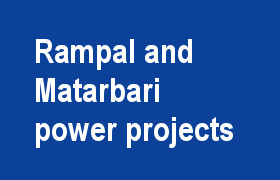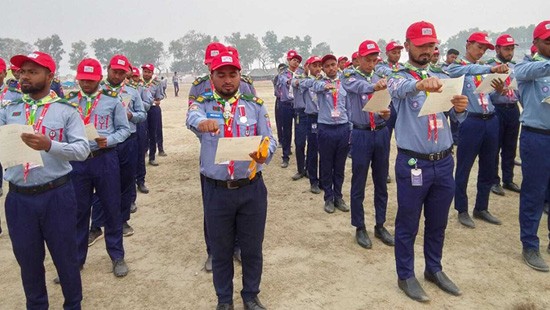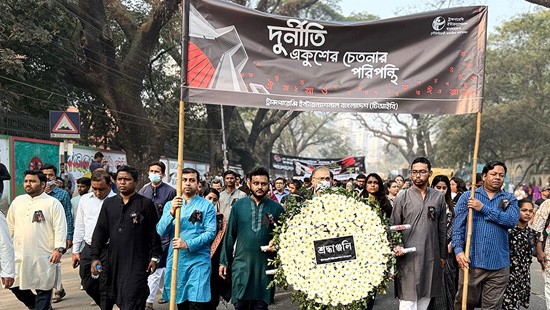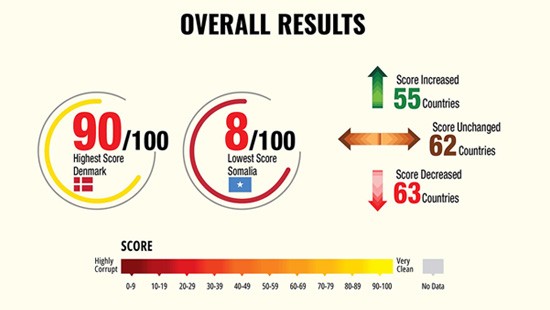Published: 16 April 2015
A TIB study ‘Rampal and Matarbari Power Projects: Governance Challenges in Environmental Impact Assessment and Land Acquisition’, released on 16 April 2015 unearthed a series of irregularities and unethical transactions of money in coal-based Rampal and Matarbari power plant projects at different levels. The study investigated governance challenges in the processes of environmental impact assessment and land acquisition for Rampal and Matarbari coal-fired thermal power plants. It may be mentioned here that the government has undertaken two coal -based mega power projects at Rampal and Matarbari with a target of producing 1320 megawatt each at a cost of Tk 145.10 billion and Tk 360 billion respectively. The Rampal project will be implemented by India-Bangladesh Friendship Co Ltd and Matarbari by Coal Power Generation Co Bd Ltd.The study found that the Environment Impact Assessment (EIA) of Rampal project was conducted by the same party (Centre environmental and Geographic Information Services – CIGIS, Bangladesh government’s body). Similarly, the EIA of the Japanese-funded Matarbari project was conducted by a Japanese company (Tokyo Electric Services Co. Ltd). Due to the possibilities of conflict of interest, these EIAs failed to achieve the international standards of neutrality. Moreover, opinions of the participants of the mass hearing were ignored while finalizing the EIA in Rampal project and locals were pushed to participate in the mass hearing in the face of threat from the local influential political leaders. National level hearing for EIA in Matarbari was not held while views exchange meetings were held outside project area and even opinions from those meetings were not incorporated. In addition, the Department of Environment (DoE) issued the clearance certificate to these projects although neither of the selected lands are empty or industrial plots. Interestingly, the views of the forest department was completely ignored for Rampal project where EIA was done after completing earth filling. The DoE’s silence on this matter was conspicuous and it refrained from taking any action that clearly violated the law.The study also found, among others, that both projects didn’t maintain safe distance from Environmental Critical area (ECA), inadequately considered pollution of ash, while Rampal project didn’t consider pollution caused by coal transport through the Sundarbans, didn’t assess the impact of water withdrawal and discharge, hid information of wildlife sanctuary, and showed the Sundarbans as ‘residential’ and ‘rural’ areas.It may be observed that local people protested coal-fired thermal power plant near Sundarbans, and various organizations arranged human chain, essay writing, memorandum submission, filing petition in court etc. Ramsar and UNESCO also expressed their concern about setting such type of power plant near the Sundarbans.
|
Launching the report, TIB’s Executive Director Dr. Iftekharuzzaman said some rules in acquiring land for two coal-fired power plants -- in Rampal and in Matarbari – were violated while those evicted from their land are still struggling to get compensation. It was found by the study that the victims had to bribe officials three to 10 percent of their recompense in advance to receive the money. In both projects, land acquisition was completed and handed over to the implementing agencies by evicting land and shrimp field owners without giving prior notice as required under section 6 and 7 of the Land Acquisition Act 1982. In Rampal, police and political activists were used to evict people from their land and shrimp field, the study said.
Rampal and Matarbari projects didn’t maintain safe distance from Environmental Critical area, inadequately considered pollution of ash, while Rampal project didn’t consider pollution caused by coal transport through the Sundarbans, didn’t assess the impact of water withdrawal and discharge, hid information of wildlife sanctuary, and showed the Sundarbans as ‘residential’ and ‘rural’ areas
Through collusion of administration officials and local influential, compensations for shrimp projects were overestimated, although not all the shrimp fields cultivate shrimp. A total of 10 shrimp fields existed in Matarbari, but showing 25 shrimp fields, 114 fraud owners of those fields misappropriated compensation of approximately Tk 23 crore. Most of the compensated persons were not actual leasers of shrimp fields. In Matarbari, a vested quarter withdrew Tk 8 crore against an abandoned salt factory.It was found that people had to pay unauthorized payments at every stage of compensation disbursement. In every file processing for paying compensation, the affected people had to pay 3.0 to 10 per cent of the total compensation money as bribe and a section of the administration officials were involved in this unlawful act. According to the respondents, they paid unauthorized payment generally at two tiers, firstly at union parishad to collect varieties of certificates and secondly at land acquisition section of DC office. Out of more than 3681 applications for compensations relating to Matarbari plant, only 492 people have been compensated. |
|








